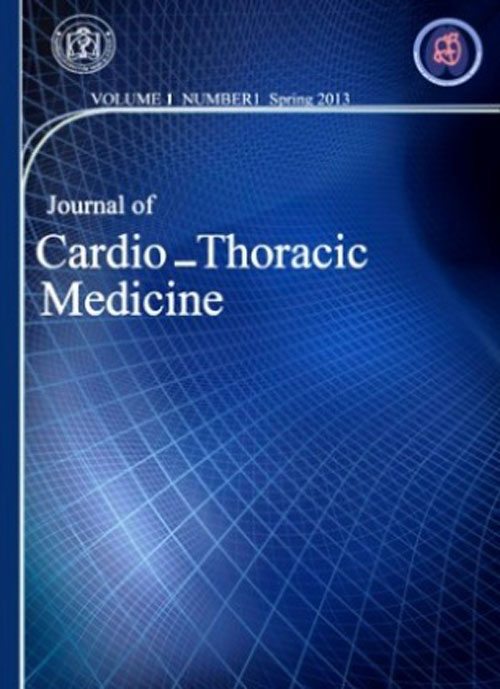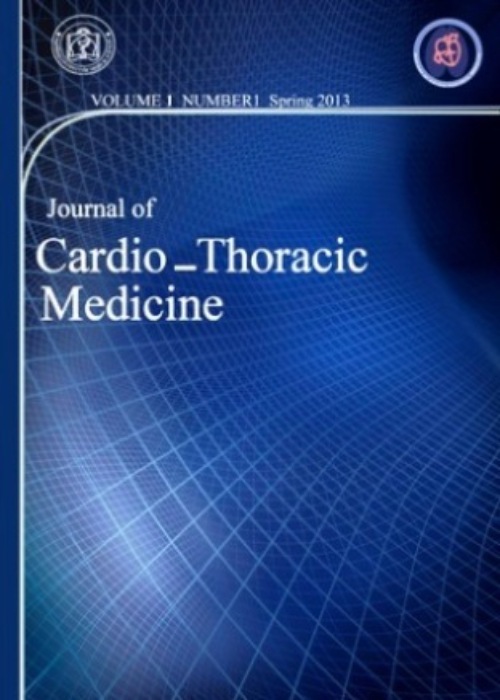فهرست مطالب

Journal of Cardio -Thoracic Medicine
Volume:7 Issue: 2, Spring 2019
- تاریخ انتشار: 1398/03/11
- تعداد عناوین: 8
-
-
Pages 433-441IntroductionNo-reflow increases the complications and mortality rate of primary percutaneous coronary intervention (PCI). Therefore, it is important to identify patients at a higher risk of developing no-reflow. This study aimed to systematically review the prognostic value of the platelet-to-lymphocyte ratio (PLR) to predict no-reflow.Materials and MethodsThe databases, such as Pubmed, EMBASE, and Web of Knowledge were searched for the relevant studies. Two authors independently performed data extraction and quality assessment of the included studies. In this meta-analysis, sensitivity and specificity of PLR, as well as the pooled odds ratio were calculated to predict no-reflow and compared with the pooled means of PLR in no-reflow and reflow groups.ResultsAccording to the results obtained from six out of eight studies in this systematic review, there was a significant association between PLR and no-reflow. Moreover, a pooled six-fold increase of no-reflow risk was observed in the high PLR group. Pooled sensitivity and specificity of PLR to predict no-reflow was 65% (CI95%: 61%-69%) and 77% (CI95%: 76%-79%), respectively. The mean pooled of PLR in the no-reflow group was significantly 65.2 (CI95%: 26.7-103.8) units higher than that in the reflow group.ConclusionsThe PLR is a significant predictor of no-reflow in STEMI patients subjected to primary PCI which can be used alone or in combination with other markers to identify patients at higher risk of developing no-reflow.Keywords: Platelet-to-lymphocyte ratio, No-reflow, ST Elevation Myocardial Infarction, Prognosis, Meta-analysis
-
Pages 442-446IntroductionAmyotrophic lateral sclerosis (ALS) is a neurogenic progressive disease that leads to muscle atrophy. The purpose of this study was to evaluate pulmonary function test (PFT) in patients with ALS and its correlation with ASL symptoms.Materials and MethodsThis cross-sectional study was performed on 32 ALS patients at Ghaem Hospital, Mashhad, Iran. All patients filled out a demographic form and underwent body plethysmography to determine forced vital capacity (FVC), forced expiratory volume in 1 sec (FEV1), and FEV1/FVC indexes based on their gender and age. Blood samples were also collected to analyze atrial blood gas (ABG) and the levels of oxygen and carbon dioxide. Finally, the data were analyzed by using SPSS20 software.ResultsThe mean age of the patients was 61.66±13.6 years. The prevalence of ALS was higher in females than in males. The study of the symptoms of the disease (87.1%) of the patients in the study was motor disorder, (0.31%) swallowing disorder, (48.0%) cough and shortness of breath and (40.0%) speech impairment. The results showed that there was a significant relationship between hypercarbia and night oxygen saturation , which the hypercarbia abundance was higher among patients whose night oxygen saturation was SO2 ˂90. But there was no significant relationship between hypercarbia and hypoxemia with symptoms of the disease.. Other results showed that the FEV1 test with swallowing disorder (P = 0.01) and cough and shortness of breath (P = 0.02) the results of FVC test with swallowing disorder (P = 0.01) and cough and shortness of breath (P = 0.02) and Also, there was a significant relationship between FEV1 / FVC test with swallowing disorder (P = 0.01) and cough and shortness of breath (P = 0.01) so that, With the normalization of the Pulmonary Function Test and the improvement of the patients , the symptoms of the disease also decreased.ConclusionsOverall, the results indicate that early detection of pulmonary involvement in patients with ALS can lead to interventions such as oxygen therapy and reduce symptoms and help improve their quality of life.Keywords: Amyotrophic lateral sclerosis, Pulmonary function test, Symptoms
-
Pages 447-449Foreign bodies in upper airway may have various presentations and be life threatening. Leeches can attach to upper airway and cause serious problems. Herein we report a 55-year-old man with hemoptysis due to attachment of leech and explain our technique for its removal.Keywords: Bronchoscopy, Cryotherapy, Foreign body, Leech
-
Pages 450-452Cardiac myxoma is usually a benign tumor in the left atrium that accounts for more than 50% of primary cardiac tumors. A 55-year-old female referred to our hospital with chest pain, referred pain to the left hand, and severe dyspnea. Transthoracic Doppler Echocardiography was performed and the results showed a large and mobile left atrial mass without any attachment to the interatrial septum. In addition, the three-vessel disease was detected using angiography. Myxoma was resected followed by coronary artery bypass grafting surgery.Keywords: myxoma, Coronary artery bypass grafting, Thromboembolism
-
Pages 453-455IntroductionPatients with primary acute aortic dissection are at higher risk of complications, including increasing aortic aneurysm diameter, aortic rupture, aortic pseudo aneurysm, and recurrent aortic dissection. Case presentation We presented the case of a recurrent pseudo aneurysm and rupture of the aorta in the distal ascending aorta and proximal arch 3 years after the initial procedure for acute aortic dissection. The patient had bleeding from previous skin incision. In computed tomography angiography, the site of rupture of the aorta and abnormal communication with sternum were confirmed. Conclusion Recurrent aortic dissection is a catastrophic event and has high mortality; however, it is rare and is treated in a short time by redo surgery.Keywords: Aortic Dissection, Aortic Pseudoaneurysm, Cardiac Surgery
-
Pages 456-457A 60-year-old male presented with dyspnea and chest pain. He was referred with massive bulky mass. A mass in the left lung was observed using chest X-ray (Figures 1). A computed tomography scan of the chest showed a mass on the left lung with complete lung collapse Figures 2 (A, B). The needle biopsy was performed and the case was diagnosed with solitary fibrous tumor. Subsequently, the patient underwent complete resected open thoracotomy. In our case, the mass dimension was 50 × 35 cm weighting 5.600 gr Figures 3 (A,B).Keywords: solitary fibrous tumor, Pleura, Diagnose
-
Extraction of chicken bone swallowing 10th day after ingestion with penetrating the esophageal wallsPages 458-459A 23-year-old male referred with a history of chicken bone swallowing a week ago (Figure 1). Endoscopy was performed at our center and a chicken bone was found penetrating the esophageal walls (Figure 2). The patient was managed successfully using flexible endoscopy and the chicken bone was removed.Keywords: Foreign Bodies, Esophageal perforation, Endoscopy, Treatment
-
Pages 460-461A 17-year-old female presented with dyspnea, chest pain, and a very large cyst occupying the entire right hemithorax Figure 1(A, B). The patient is under full cyst extending to membrane Figure 2 (A, B).Keywords: Hydatid Cyst, Hemithorax, outcomes


